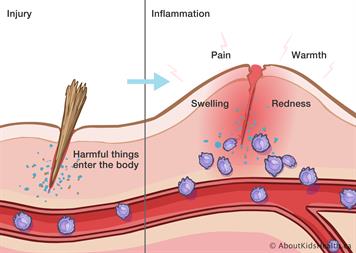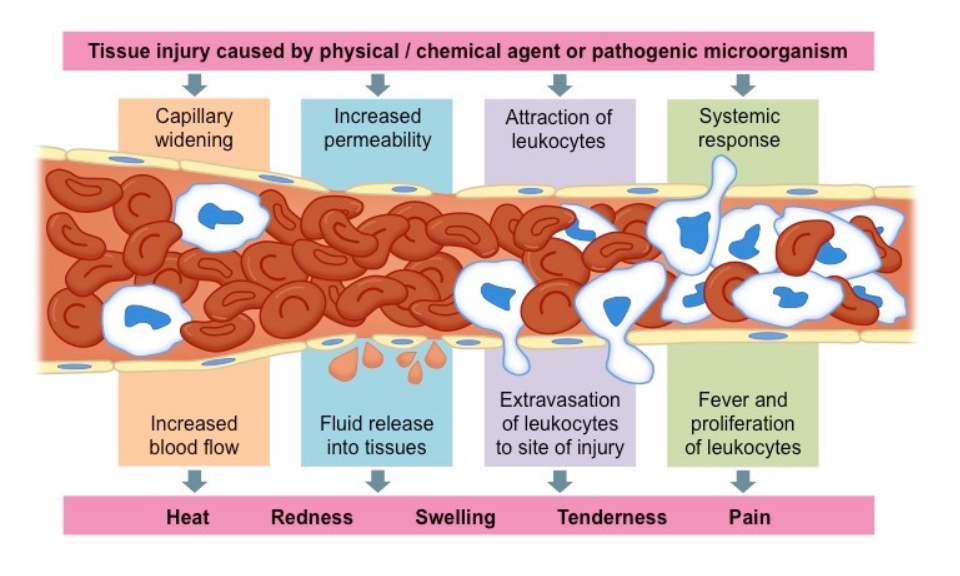Inflammatory Response Study Guide
Introduction:
A wound or tissue damage or entry of a foreign object into the body can cause the tissue adjacent to the damaged or infected region to become swollen or reddened, causing pain. The process of inflammation involves two cellular events of inflammation and immune system inflammation.
What is an inflammatory response?
- The inflammatory response can occur over a short period but is severe, called acute, or can occur over a long time and recurrent, called chronic.
- Acute inflammation is usually caused because of tissue damage or pathogens.
- In contrast, chronic inflammation occurs because of persistent infection, autoimmune disorders, overactive immune responses, or entry of foreign objects leaving their traces.
- The cells involved in inflammatory reactions are neutrophils and eosinophils for acute inflammation; and lymphocytes, mast cells, and histiocytes for chronic inflammation.
The inflammation process results in one or more of these five symptoms: redness, heat, swelling, pain, and loss of function. These symptoms need not be explicit and can be silent. This can often lead to loss of energy or fatigue.
Steps in an Inflammatory Response
Inflammation takes place as a result of cellular and immunological events.
- As soon as the physical trigger for inflammatory response is sensed, an immediate cellular response is manifested by releasing inflammatory mediators like bradykinins and histamines.
- Blood starts to rush towards the injured region because the blood vessels dilate because of these chemicals.
- The breakdown of cells because of the tissue damage results in the accumulation of the cellular fluid into the surrounding tissues, which causes the injured area to swell.
- The increase in blood flow is responsible for the redness of the tissue and warmth. As these regions are flushed with nerve endings, the tissue damage triggers a stimulus sent to the brain, perceived as pain until the tissue is healed.
- Along with these chemicals, the immune cells are inflammation by the blood flowing into the inflamed region. This is the stage of recruitment.
- Besides these chemicals, sentinel cells work immediately on the foreign object that enters the body. This is called recognition. These chemicals can also get into the blood by crossing the blood-brain barrier, increasing body temperature. It leads to a range of other events in the body to effectively fight against the foreign aspects entering the body and restore the healing process.
- The whole inflammatory response and its effects can result in the arrest of the movement of the affected region that results in loss of function.
- The process of phagocytosis removes the damaged cells and foreign bodies.
- The final step is accomplished when cytokines and growth factors are released by the white blood cells to initiate the process of repair, which is the healing of the damaged tissue.
Conclusion
- Thus, the inflammatory response is a very complex process involving numerous chemicals and many different cells.
- This process helps protect the body from foreign invaders that otherwise will destroy the entire body, serving as a defense mechanism.
- But it does not stop with that as it goes beyond healing the damaged tissue and helps in recovery.
- However, sometimes prolonged inflammation can accumulate or increase inflammatory chemical overload in the body, resulting in harmful effects on the body processes, causing unwanted symptoms.
FAQs:
1. What are the 5 inflammatory responses?
The five cardinal signs of inflammatory responses are pain, heat, redness, swelling, and loss of function.
2. What are the steps of inflammatory response?
The four steps of the inflammatory response recognize the damaged tissue, recruitment of inflammatory cells, removal of extraneous objects, and repair the damaged tissue.
3. What are the types of inflammatory responses?
There are two types of inflammatory response – acute and chronic.
4. What are the signs of an inflammatory response?
The signs of an inflammatory response are pain, heat, redness, swelling, and loss of function. The inflammatory response can be silent, and not always all the five signs will occur at one instance.
We hope you enjoyed studying this lesson and learned something cool about Inflammatory Response! Join our Discord community to get any questions you may have answered and to engage with other students just like you! Don’t forget to download our App to experience our fun, VR classrooms – we promise, it makes studying much more fun! 😎
Sources:
- What is an inflammation?. https://www.ncbi.nlm.nih.gov/books/NBK279298/. Accessed 24 Nov, 2021.
- Acute Inflammatory Response. https://pubmed.ncbi.nlm.nih.gov/32310543/. Accessed 24 Nov, 2021.
- Inflammatory Response. https://flexbooks.ck12.org/cbook/ck-12-biology-flexbook-2.0/section/13.46/primary/lesson/inflammatory-response-and-leukocytes-bio/. Accessed 25 Nov, 2021.
- Everything you need to know about inflammation. https://www.medicalnewstoday.com/articles/248423#takeaway. Accessed 25 Nov, 2021.
- Inflammation. https://www.webmd.com/arthritis/about-inflammation. Accessed 25 Nov, 2021.


